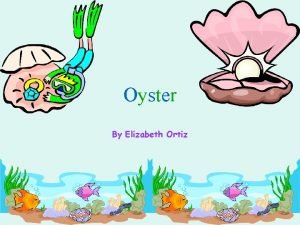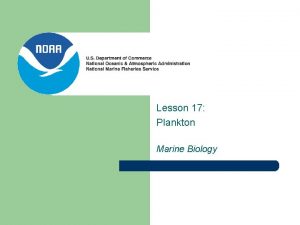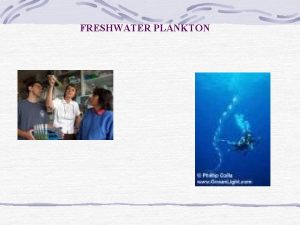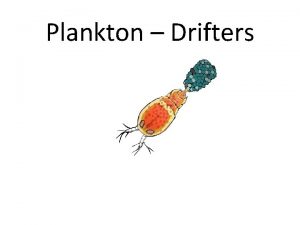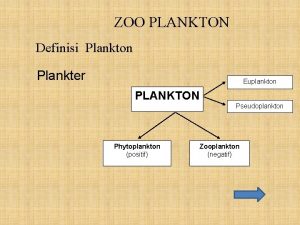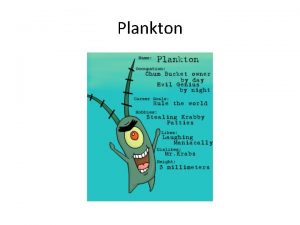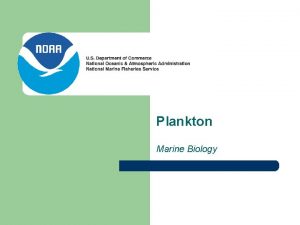Identification of Freshwater Plankton The term plankton was















- Slides: 15

Identification of Freshwater Plankton The term ‘plankton’ was coined by Victor Henson in 1887 to designate the heterogeneous assemblage of suspended microscopic materials, minute organisms and detritus in water which wander at mercy of winds, currents and tides.

Identification Characters Cells spherical to ellipsoidal, solitary or aggregated, small smooth walled, cup-shaped or laminate, with or without a pyrenoid, reproduction by autospores, free living or symbiotic. Chlorella

• Colonies stellate to disc-shaped, monostromatic disc entire or perforate, cells 4 to 128, polygonal, marginal cells mostly with one, two or four processes, chloplast single parietal with a pyrenoid, diffuse in mature cells with one or more pyrenoid, cells multinucleate, reproduction by zoospores and isogamets, planktonic. Pediastrum

• Filaments unbranched, usually sessile when young or free floating, • protoplast enclosed by the conjoined halves of two successive H-pieces, each protoplast surrounded by thin cellulose layer, • interpolation of H-pieces in diving cell, cells uninucleate with a central vacuole, • chloroplast in young cells irregularly expanded and perforate and reticulate sheet, without pyrenoid, zoospores bi-or quadriflagellate. Microspora

Cladophora • Filaments repeatedly branched with basal-distal differentiation in the habit of branching, • lateral branches arise close to the upper septa and often appear to be bi or trichotomous (due to evection), cells 5 -20 times longer than breadth, multinucleate, • cell wall thick and stratified, reticulate chloroplast with pyrenoids at intersections, reproduction by quadriflagellate zoospores and biflagellate gamets,

• Cells uniflagellate, fusiform to acicular, flexible, constantly change their shape, • posterior end more or less pointed, gullet and eye spot anterior, contractile vacuole 1 to many. Chloroplasts many, • discoid to band shaped, pyrenoids may be present, flagellum bifurcated at base, neuromotor apparatus present, planktonic.

Spirogyra • Filaments long, unbranched, cells as long as broad or several times the breadth, chloroplast 1 to 16, parietal, ribbon shaped with half to 3 or rarely 8 left hand spirals, pyrenoids many in a single series, lying equidistant from one another, gamets physiologically anisogamous, aygopore in either of the conjugating cells.

Fragilaria • Cells attached side by side to form ribbon shaped colonies (rarely flat stellate), linear to fusiform in valve view and rectangular in gridle view, bilaterally symmetrical in both axis, pseudoraphe present, valves with transverse striae or punctae, planktonic.

Closterium Cells solitary, elongate without a median constriction, poles distinctly attenuated but without spines, chlorplasts two, sickle shaped, with or without longitudinal ridges, pyrenoids mostly few.

Diatoma Frustules lanceolate to linear in valve view, often subcapitate poles, valves bilaterally symmetrical in both axis, septa transverse, many run across the valves to the inercalary bands of the gridle, pseudoraphe faint, valve and gridle ornamented, planktonic.

Navicula Frustules symmetrical, rectangular in gridle view, raphe and axial filed straight, latter is narrow and without any expansion, lateral to axial field striae or punctuate in transverse rows, planktonic.

Nitzschia Frustules with tranverse septa, keel single, excentric, on lateral margin of valve, raphe lies within it, keeled margin of one valve faces the unkeeled margin of the other valve, rapheal fissure with uniseriate row of circular pores (carinal dots), planktonic.

Nostoc Trichomes within a definite sheath, contorted, colonical matrix firm with a definite shape, heterocyst, intercalary, akinete solitary or in chains.

Oscillotoria Trichome unbranched and without a distinct sheath, solitary and scattered or form expanded masses, trichomes may dissociate easily, mostly straight or in irregular spirals, ends distinctly marked, attenuated, rounded bent or coiled and with or without calyptras, cells discoidal or cylindrical, homogonia may have a thin sheath

Vorticella Body inverted bell shaped, solitary (never colonial), usually in groups stalk unbranched, long and contractile, it is secreted by aboral tip, oral groove, circular around the edge of the cup and extends inward, plugged by a raised disc, two circles of cilia on the disc, endoplasm with a long and horse-shoe shaped macronucleus and a small micronucleus, colourless, green or blue.
 Texas freshwater fish identification
Texas freshwater fish identification Positive identification example
Positive identification example Define meroplankton
Define meroplankton What is the scientific name for an oyster
What is the scientific name for an oyster Food chain of rabbit
Food chain of rabbit Plankton straining
Plankton straining What exactly is plankton?
What exactly is plankton? Plankton
Plankton Plankton straining
Plankton straining Octopus larvae facts
Octopus larvae facts Desert herbivore
Desert herbivore Drifting plants
Drifting plants Do shrimp eat plankton
Do shrimp eat plankton Plankton watch
Plankton watch What are plankton nekton and benthos
What are plankton nekton and benthos Importance of plankton
Importance of plankton



